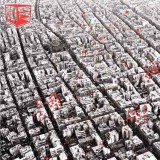Supervisor:
2006
Arts and professions that once supported the trade and the economy of entire cities are disappearing; being unable to catch up new speeds and ways of life. Redefinition according to the new means , the possibilities, the contradictions and dynamic. If they are combined with technology that is developed rapidly and the vertiginous exchange of information, they might revive that glamorous past with future principals and create new places of “autonomous work” of the post-industrial city.
Spaces that die from indifference in the centre of post-industrial cities that remain incompetent to react.
In our days the significance of Post-fordism, signals a social model (which we can also consider as designing) where “the way of production is not dominated by forms of vertical incorporated accumulation … but by forms of flexible accumulation, capable of including different ways, years and places of production into the network: from the robot-type factory to the high-tech cheese dairy (cow house) and the Mexican Mequiladoras*… Essential is the connection between the information, the communication, the knowledge and the production… This is the cohesive web of Post-fordistic society”.
An enormous network of craftsmanship; a new type of “autonomous work” for the following era. Adapting, assembling and altering working spaces for the handicraft post-industrial production, which have been considered in various types.
Creative individuals, artists, craftsmen or teams of craftsmen can select between a whole of (applied) arts and techniques and afterwards they are being instructed in sectors of computers, economic management, organisation and distribution and they watch seminars on the selected craftsmanship. The next step is the choice of location (ex. some abandoned post-industrial building) and the acquisition of equipment. More specifically, the type of cabin that is entitled to the type of craftsmanship they chose.
Experimental Post-fordistic, professional cabins are placed into a building on the Ernestou Emprar street in Thessaloniki with possibility of spreading on the entire city.
The 36 cabins in the building, viewed as a micrograph of the world network, can initially function as an obvious example for the possibilities of interaction, collaboration, interpersonal forms of production and distribution, exchange of experiences and knowledge via internet.
The placement of teams of cabins in abandoned spaces can function dynamically and beneficially. The cabin expands and being accommodated in a scattered system of voids creating a craft “lace” in the existing urban web, the new type of work and new way of life lace. A placement like that differentiates the facets and the interior of these spaces. Progressively movement is perceived and the sense of shabbiness stops being unpleasant.
The cabins as “cages” or capsules that encompass energy; spread and revive the dead cells of wounded neighborhoods. Little shocks that can transform a series of legends and abandoned craftsmanship into reality and the haunted post-industrial castles into script production towers of the post-industrial society.
*Maquiladora (or maquila) are factories that import duty-free and tax-free materials and equipment, for assembling or manufacturing an object and then re-extract the assembled product usually back to the origin country. The main use of these installations is to assemble the imported parts. Maquiladoras usually belong in their 100% to the country that exports the materials.
